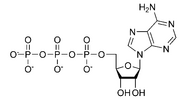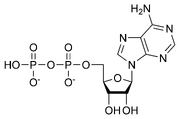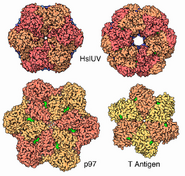Assessment |
Biopsychology |
Comparative |
Cognitive |
Developmental |
Language |
Individual differences |
Personality |
Philosophy |
Social |
Methods |
Statistics |
Clinical |
Educational |
Industrial |
Professional items |
World psychology |
Biological: Behavioural genetics · Evolutionary psychology · Neuroanatomy · Neurochemistry · Neuroendocrinology · Neuroscience · Psychoneuroimmunology · Physiological Psychology · Psychopharmacology (Index, Outline)


ATPases are a class of enzymes that catalyze the decomposition of adenosine triphosphate (ATP) into adenosine diphosphate (ADP) and a free phosphate ion. This dephosphorylation reaction releases energy, which the enzyme (in most cases) harnesses to drive other chemical reactions that would not otherwise occur. This process is widely used in all known forms of life.
Some such enzymes are integral membrane proteins (anchored within biological membranes), and move solutes across the membrane. (These are called transmembrane ATPases).
Functions[]

Transmembrane ATPases import many of the metabolites necessary for cell metabolism and export toxins, wastes, and solutes that can hinder cellular processes. An important example is the sodium-potassium exchanger (or Na+/K+ATPase), which establishes the ionic concentration balance that maintains the cell potential. Another example is the hydrogen potassium ATPase (H+/K+ATPase or gastric proton pump) that acidifies the contents of the stomach.
Besides exchangers, other categories of transmembrane ATPase include co-transporters and pumps (however, some exchangers are also pumps). Some of these, like the Na+/K+ATPase, cause a net flow of charge, but others do not. These are called "electrogenic" and "nonelectrogenic" transporters, respectively.
Mechanism[]
The coupling between ATP hydrolysis and transport is more or less a strict chemical reaction, in which a fixed number of solute molecules are transported for each ATP molecule that is hydrolyzed; for example, 3 Na+ ions out of the cell and 2 K+ ions inward per ATP hydrolyzed, for the Na+/K+ exchanger.
Transmembrane ATPases harness the chemical potential energy of ATP, because they perform mechanical work: they transport solutes in a direction opposite to their thermodynamically preferred direction of movement—that is, from the side of the membrane where they are in low concentration to the side where they are in high concentration. This process is considered active transport.
For example, the blocking of the vesicular H+-ATPAses would increase the pH inside vesicles and decrease the pH of the cytoplasm.
ATP synthase[]
The ATP synthase of mitochondria and chloroplasts is an anabolic enzyme that harnesses the energy of a transmembrane proton gradient as an energy source for adding an inorganic phosphate group to a molecule of adenosine diphosphate (ADP) to form a molecule of adenosine triphosphate (ATP).
This enzyme works when a proton moves down the concentration gradient, giving the enzyme a spinning motion. This unique spinning motion bonds ADP and P together to create ATP.
ATP synthase can also function in reverse, that is, use energy released by ATP hydrolysis to pump protons against their thermodynamic gradient.
Human genes[]
- Na+/K+ transporting: ATP1A1, ATP1A2, ATP1A3, ATP1A4, ATP1B1, ATP1B2, ATP1B3, ATP1B4
- Ca++ transporting: ATP2A1, ATP2A2, ATP2A3, ATP2B1, ATP2B2, ATP2B3, ATP2B4, ATP2C1
- Mg++ transporting: ATP3
- H+/K+ exchanging: ATP4A, ATP4B
- H+ transporting, mitochondrial: ATP5A1, ATP5B, ATP5C1, ATP5C2, ATP5D, ATP5E, ATP5F1, ATP5G1, ATP5G2, ATP5G3, ATP5H, ATP5I, ATP5J, ATP5J2, ATP5L, ATP5L2, ATP5O, ATP5S
- H+ transporting, lysosomal: ATP6AP1, ATP6AP2, ATP6V1A, ATP6V1B1, ATP6V1B2, ATP6V1C1, ATP6V1C2, ATP6V1D, ATP6V1E1, ATP6V1E2, ATP6V1F, ATP6V1G1, ATP6V1G2, ATP6V1G3, ATP6V1H, ATP6V0A1, ATP6V0A2, ATP6V0A4, ATP6V0B, ATP6V0C, ATP6V0D1, ATP6V0D2, ATP6V0E
- Cu++ transporting: ATP7A (see also ATP7A), ATP7B
- Class I, type 8: ATP8A1, ATP8B1, ATP8B2, ATP8B3, ATP8B4
- Class II, type 9: ATP9A, ATP9B
- Class V, type 10: ATP10A, ATP10B, ATP10D
- Class VI, type 11: ATP11A, ATP11B, ATP11C
- H+/K+ transporting, nongastric: ATP12A
- type 13: ATP13A1, ATP13A2, ATP13A3, ATP13A4, ATP13A5
See also[]
AAA proteins
Additional images[]
External links[]
- "ATP synthase - a splendid molecular machine"
- MeSH ATPase
- UMich Orientation of Proteins in Membranes families/superfamily-5
- Proton or sodium translocating F- and V-type ATPases
- UMich Orientation of Proteins in Membranes families/superfamily-22
- Different conformations of P-type ATPase
Uniporter - Cotransporter
Symporter: Na+/K+/2Cl- - Na/Pi3 - Na+/Cl- - Na/glucose
Antiporter (exchanger): Na+/H+ - Na+/Ca2+ - Cl-/HCO3- (Band 3)
ATPase: F - V - H/K+ - Na+/K+ - Ca+ (SERCA, Plasma membrane)
Halorhodopsin - Proton pump
Hydrolases: acid anhydride hydrolases (EC 3.6) | |
|---|---|
| 3.6.1 |
Pyrophosphatase (Inorganic, Thiamine) - Apyrase - Thiamine triphosphatase |
| 3.6.3-4 |
ATPase |
| 3.6.5 | |
Acid anhydride hydrolases: ATPases (EC 3.6.3-3.6.4) | |
|---|---|
| 3.6.3 |
Cu++ (Menkes, Wilson) - Ca+ (SERCA, Plasma membrane) - Na+/K+ - H+/K+ - ATP synthase - H+ (F-type) - H+ (V-type) |
| 3.6.4 |
Dynein - Kinesin - Myosin |
| This page uses Creative Commons Licensed content from Wikipedia (view authors). |
